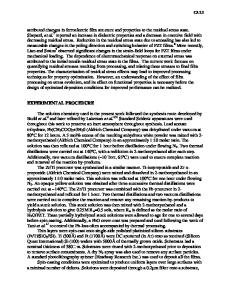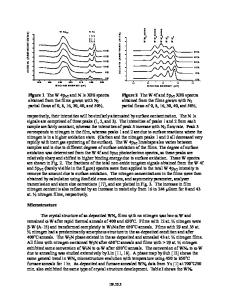Residual Stress Reduction in Sputter Deposited thin Films by Density Modulation
- PDF / 2,869,617 Bytes
- 6 Pages / 612 x 792 pts (letter) Page_size
- 96 Downloads / 309 Views
1224-FF05-22
RESIDUAL STRESS REDUCTION IN SPUTTER DEPOSITED THIN FILMS BY DENSITY MODULATION Arif S. Alagoz1, Jan-Dirk Kamminga2,3, Sergey Yu. Grachev4, Toh-Ming Lu5 and Tansel Karabacak1 1 Department of Applied Science, University of Arkansas at Little Rock, Little Rock, AR 72204, U.S.A. 2 Materials Innovation Institute M2i, Mekelweg 2, 2628 CD Delft, Netherlands 3 Department of Materials Sciences and Engineering, Delft University of Technology, Mekelweg 2, 2628 CD Delft, Netherlands 4 Saint-Gobain Recherche, 39 quai Lucien Lefranc, B.P. 135, 93303 Aubervilliers, France 5 Department of Physics, Applied Physics and Astronomy, Rensselaer Polytechnic Institute, Troy, NY 12180, U.S.A. ABSTRACT Control of residual stress in thin films is critical in obtaining high mechanical quality coatings without cracking, buckling, or delamination. In this work, we present a simple and effective method of residual stress reduction in sputter deposited thin films by stacking low and high material density layers of the same material. This multilayer density modulated film is formed by successively changing working gas pressure between high and low values, which results in columnar nanostructured and dense continuous layers, respectively. In order to investigate the evolution of residual stress in density modulated thin films, we deposited ruthenium (Ru) films using a DC magnetron sputtering system at alternating argon (Ar) pressures of 20 and 2 mTorr. Wafer’s radius of curvature was measured to calculate the intrinsic thin film stress of multilayer Ru coatings as a function of total film thickness by changing the number of high density and low density layers. By engineering the film density, we were able to reduce film stress more than one order of magnitude compared to the conventional dense films produced at low working gas pressures. Due to their low stress and enhanced mechanical stability, we were able to grow these density modulated films to much higher thicknesses without suffering from buckling. Morphology and crystal structure of the thin films were investigated by scanning electron microscopy (SEM), transmission electron microscopy (TEM), and X-ray diffraction (XRD). A previously proposed model for stress reduction by means of relatively rough and compliant sublayers was used to explain the unusually low stress in the specimens investigated. INTRODUCTION It is well known that residual (also called intrinsic) stress naturally evolves during growth of sputter deposited thin films. The control of this stress is essential for high mechanical quality coatings without cracking, buckling, or delamination [1-2]. Dependence of residual stress on process parameters and microstructure is systematically investigated by many research groups. Haghiri-Gosnet et al. [3] and Windischmann [4] showed strong correlation between residual stress and Thornton’s structure zone model (SZM) [5-9] for sputtered thin films. Low density thin films deposited at high argon pressure and low temperature (regime Zone I) have almost zero residual stress. How
Data Loading...








